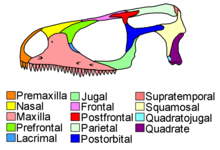Lepidosauromorpha
| Lepidosauromorphs | |
|---|---|

| |
| Skull of Sophineta cracoviensis
| |

| |
| Collage of five Malayopython reticulatus .
| |
| Scientific classification | |
| Domain: | Eukaryota |
| Kingdom: | Animalia |
| Phylum: | Chordata |
| Class: | Reptilia |
| Clade: | Sauria |
| Clade: | Lepidosauromorpha Benton, 1983 |
| Subgroups | |
|
see text. | |
| Synonyms | |
| |
Lepidosauromorpha (in
.Lepidosauromorphs are distinguishable from archosauromorphs (reptiles closer to archosaurs) by their primitive sprawling gait (allowing for the same sinusoidal trunk and tail movement seen in fish), the sliding "joint" between the coracoids and the sternum (for a longer stride), and their pleurodont dentition. In contrast, Archosauromorphs possess a parasagittal gait, a reduction in their dermal girdle, a reduction and/or loss of the sternum, and a more thecodont dentition. Living lepidosauromorphs have retained an ectothermic ("cold blooded") metabolism, unlike the ancestral condition in archosauromorphs.
While some putative stem-lepidosauromorphs like Palaeagama are known from the Late Permian, the oldest definitive lepidosauromorphs, Sophineta and Paliguana, are known from the Early Triassic.[4][5] Taytalura from the early Late Triassic of Argentina is the most complete fossil of an early lepidosauromorph and is one of the few fossils robustly inferred as an early evolving lepidosauromorph.[6] The Kuehneosauridae, a family of reptiles with elongated ribs which allowed them to glide akin to living gliding lizards have been historically typically considered early lepidosauromorphs. However, several recent studies have been found them in other positions within Sauria, including Archosauromorpha.[7] Almost all non-lepidosaurian lepidosauromorphs became extinct by the end of the Triassic, the with the latest non lepidosaur-lepidosauromorphs being Marmoretta from the Middle Jurassic of Britain and an indeterminate form from the Middle Jurassic Moskvoretskaya Formation of Russia, which appear to be closely related to Fraxinisaura from the Middle Triassic of Germany.[5][8][9] Other studies have recovered Marmoretta as a stem-squamate.[10]
Subgroups
- †Kuehneosauridae?
- †Choristodera?
- †Helveticosauridae?
- †Cargninia
- †Coartaredens?
- †Feralisaurus?
- †Fraxinisaura
- †Lacertulus?
- †Marmoretta
- †Megachirella
- †Paliguana
- †Pamelina?
- †Sophineta
- †Tamaulipasaurus
- †Taytalura
- †Vellbergia
- †Vinitasaura
- Lepidosauria
See also
References
- PMID 24063680.
- ISBN 978-1-138-33293-5.
- ^ "Pan-Lepidosauria". RegNum.
- ^ Susan E. Evans and Magdalena Borsuk−Białynicka (2009). "A small lepidosauromorph reptile from the Early Triassic of Poland" (PDF). Paleontologica Polonica. 65: 179–202.
- ^ PMID 34428965.
- S2CID 237307957.
- S2CID 219018618, retrieved 2021-08-22
- S2CID 236282947.
- ISSN 0031-0239.
- S2CID 44108416.







